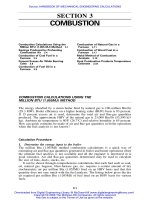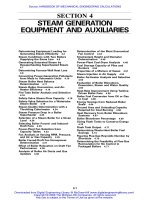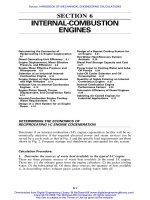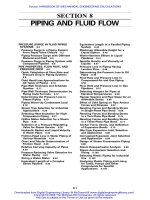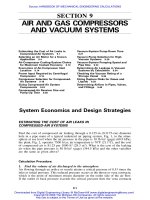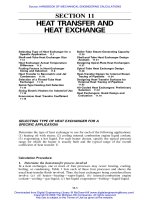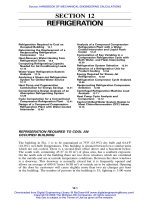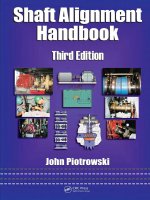Tài liệu Handbook of Electrical Engineering doc
Bạn đang xem bản rút gọn của tài liệu. Xem và tải ngay bản đầy đủ của tài liệu tại đây (3.83 MB, 631 trang )
Handbook of
Electrical Engineering
Handbook of Electrical Engineering: For Practitioners in the Oil, Gas and Petrochemical Industry. Alan L. Sheldrake
2003 John Wiley & Sons, Ltd ISBN: 0-471-49631-6
Handbook of
Electrical Engineering
For Practitioners in the Oil, Gas and
Petrochemical Industry
Alan L. Sheldrake
Consulting Electrical Engineer, Bangalore, India
Copyright 2003 John Wiley & Sons Ltd, The Atrium, Southern Gate, Chichester,
West Sussex PO19 8SQ, England
Telephone (+44) 1243 779777
Email (for orders and customer service enquiries):
Visit our Home Page on www.wileyeurope.com or www.wiley.com
All Rights Reserved. No part of this publication may be reproduced, stored in a retrieval system or transmitted in any form or by any means,
electronic, mechanical, photocopying, recording, scanning or otherwise, except under the terms of the Copyright, Designs and Patents Act
1988 or under the terms of a licence issued by the Copyright Licensing Agency Ltd, 90 Tottenham Court Road, London W1T 4LP, UK,
without the permission in writing of the Publisher. Requests to the Publisher should be addressed to the Permissions Department, John Wiley
& Sons Ltd, The Atrium, Southern Gate, Chichester, West Sussex PO19 8SQ, England, or emailed to , or faxed to
(+44) 1243 770620.
This publication is designed to provide accurate and authoritative information in regard to the subject matter covered. It is sold on the
understanding that the Publisher is not engaged in rendering professional services. If professional advice or other expert assistance is
required, the services of a competent professional should be sought.
Other Wiley Editorial Offices
John Wiley & Sons Inc., 111 River Street, Hoboken, NJ 07030, USA
Jossey-Bass, 989 Market Street, San Francisco, CA 94103-1741, USA
Wiley-VCH Verlag GmbH, Boschstr. 12, D-69469 Weinheim, Germany
John Wiley & Sons Australia Ltd, 33 Park Road, Milton, Queensland 4064, Australia
John Wiley & Sons (Asia) Pte Ltd, 2 Clementi Loop #02-01, Jin Xing Distripark, Singapore 129809
John Wiley & Sons Canada Ltd, 22 Worcester Road, Etobicoke, Ontario, Canada M9W 1L1
Wiley also publishes its books in a variety of electronic formats. Some content that appears
in print may not be available in electronic books.
Library of Congress Cataloging-in-Publication Data
Sheldrake, Alan L.
Handbook of electrical engineering : for practitioners in the oil, gas, and petrochemical
industry / Alan L. Sheldrake.
p. cm.
Includes bibliographical references and index.
ISBN 0-471-49631-6 (alk. paper)
1. Electric machinery–Handbooks, manuals, etc. 2. Petroleum engineering–Equipment
and supplies–Handbooks, manuals, etc. I. Title.
TK2000.S52 2003
621.31
042–dc21
2002192434
British Library Cataloguing in Publication Data
A catalogue record for this book is available from the British Library
ISBN 0-471-49631-6
Typeset in 10/12pt Times by Laserwords Private Limited, Chennai, India
Printed and bound in Great Britain by Antony Rowe Ltd, Chippenham, Wiltshire
This book is printed on acid-free paper responsibly manufactured from sustainable forestry
in which at least two trees are planted for each one used for paper production.
This book is dedicated to my dear wife Ilse who with great patience
encouraged me to persevere with the completion of this work.
Contents
Foreword xix
Preface xxi
Acknowledgements xxiii
About the Author xxv
1 Estimation of Plant Electrical Load 1
1.1 Preliminary Single-Line Diagrams 1
1.2 Load Schedules 2
1.2.1 Worked example 5
1.3 Determination of Power Supply Capacity 8
1.4 Standby Capacity of Plain Cable Feeders and Transformer Feeders 12
1.5 Rating of Generators in Relation to their Prime Movers 13
1.5.1 Operation at low ambient temperatures 13
1.5.2 Upgrading of prime movers 13
1.6 Rating of Motors in Relation to their Driven Machines 13
1.7 Development of Single-Line Diagrams 14
1.7.1 The key single line diagram 15
1.7.2 Individual switchboards and motor control centres 15
1.8 Coordination with other Disciplines 16
1.8.1 Process engineers 16
1.8.2 Mechanical engineers 17
1.8.3 Instrument engineers 17
1.8.4 Communication and safety engineers 18
1.8.5 Facilities and operations engineers 18
Reference 18
2 Gas Turbine Driven Generators 19
2.1 Classification of Gas Turbine Engines 19
2.1.1 Aero-derivative gas turbines 19
2.1.2 Light industrial gas turbines 20
2.1.3 Heavy industrial gas turbines 20
2.1.4 Single and two-shaft gas turbines 20
2.1.5 Fuel for gas turbines 23
2.2 Energy Obtained from a Gas Turbine 23
2.2.1 Effect of an inefficient compressor and turbine 29
2.2.2 Maximum work done on the generator 30
viii
2.2.3 Variation of specific heat 31
2.2.4 Effect of ducting pressure drop and combustion chamber
pressure drop 32
2.2.5 Heat rate and fuel consumption 35
2.3 Power Output from a Gas Turbine 36
2.3.1 Mechanical and electrical power losses 37
2.3.2 Factors to be considered at the design stage of a power plant 37
2.4 Starting Methods for Gas Turbines 39
2.5 Speed Governing of Gas Turbines 39
2.5.1 Open-loop speed-torque characteristic 39
2.5.2 Closed-loop speed-power characteristic 41
2.5.3 Governing systems for gas turbines 43
2.5.4 Load sharing between droop-governed gas turbines 44
2.5.5 Load sharing controllers 50
2.6 Mathematical Modelling of Gas Turbine Speed Governing Systems 52
2.6.1 Modern practice 52
2.6.2 Typical parameter values for speed governing systems 59
References 59
Further Reading 59
3 Synchronous Generators and Motors 61
3.1 Common Aspects Between Generators and Motors 61
3.2 Simplified Theory of Operation of a Generator 61
3.2.1 Steady state armature reaction 62
3.2.2 Transient state armature reaction 63
3.2.3 Sub-transient state armature reaction 63
3.3 Phasor Diagram of Voltages and Currents 64
3.4 The Derived Reactances 65
3.4.1 Sensitivity of x
md
, x
a
, x
f
and x
kd
to changes in physical
dimensions 67
3.5 Active and Reactive Power Delivered from a Generator 68
3.5.1 A general case 68
3.5.2 The particular case of a salient pole generator 70
3.5.3 A simpler case of a salient pole generator 71
3.6 The Power Versus Angle Chart of a Salient Pole Generator 72
3.7 Choice of Voltages for Generators 73
3.8 Typical Parameters of Generators 73
3.9 Construction Features of High Voltage Generators and Induction Motors 78
3.9.1 Enclosure 78
3.9.2 Reactances 79
3.9.3 Stator windings 79
3.9.4 Terminal boxes 80
3.9.5 Cooling methods 80
3.9.6 Bearings 80
References 81
ix
4 Automatic Voltage Regulation 83
4.1 Modern Practice 83
4.1.1 Measurement circuits 83
4.1.2 Error sensing circuit 84
4.1.3 Power amplifier 84
4.1.4 Main exciter 88
4.2 IEEE Standard AVR Models 89
4.2.1 Worked example 92
4.2.2 Worked example 92
4.2.3 Determining of saturation constants 93
4.2.4 Typical parameter values for AVR systems 97
Reference 97
5 Induction Motors 99
5.1 Principle of Operation of the Three-Phase Motor 99
5.2 Essential Characteristics 100
5.2.1 Motor torque versus speed characteristic 100
5.2.2 Motor starting current versus speed characteristic 107
5.2.3 Load torque versus speed characteristic 108
5.2.4 Sensitivity of characteristics to changes in resistances and reactances 109
5.2.5 Worked example 109
5.2.6 Typical impedance data for two-pole and four-pole induction motors 114
5.2.7 Representing the deep-bar effect by two parallel branches 114
5.3 Construction of Induction Motors 119
5.4 Derating Factors 121
5.5 Matching the Motor Rating to the Driven Machine Rating 121
5.6 Effect of the Supply Voltage on Ratings 122
5.7 Effect of the System Fault Level 123
5.8 Cable Volt-drop Considerations 123
5.9 Critical Times for Motors 125
5.10 Methods of Starting Induction Motors 125
5.10.1 Star-delta method 126
5.10.2 Korndorfer auto-transformer method 126
5.10.3 Soft-start power electronics method 127
5.10.4 Series reactor method 128
5.10.5 Part winding method 129
References 129
6 Transformers 131
6.1 Operating Principles 131
6.2 Efficiency of a Transformer 134
6.3 Regulation of a Transformer 135
6.4 Three-Phase Transformer Winding Arrangements 136
6.5 Construction of Transformers 137
6.5.1 Conservator and sealed type tanks 139
x
6.6 Transformer Inrush Current 140
References 142
7 Switchgear and Motor Control Centres 143
7.1 Terminology in Common Use 143
7.2 Construction 144
7.2.1 Main busbars 144
7.2.2 Earthing busbars 146
7.2.3 Incoming and busbar section switching device 146
7.2.4 Forms of separation 147
7.2.5 Ambient temperature derating factor 149
7.2.6 Rated normal current 149
7.2.7 Fault making peak current 149
7.2.8 Fundamental AC part 150
7.2.9 DC part 150
7.2.10 Double frequency AC part 150
7.2.11 Fault breaking current 152
7.2.12 Fault withstand duty 153
7.3 Switching Devices 154
7.3.1 Outgoing switching device for switchgear 154
7.3.2 Outgoing switching device for motor control centres 155
7.4 Fuses for Motor Control Centre Outgoing Circuits 156
7.5 Safety Interlocking Devices 157
7.6 Control and Indication Devices 158
7.6.1 Restarting and reaccelerating of motors 158
7.6.2 Micro-computer based systems 159
7.7 Moulded Case Circuit Breakers 162
7.7.1 Comparison with fuses 162
7.7.2 Operating characteristics 163
7.7.3 Cut-off current versus prospective current 164
7.7.4 i-squared-t characteristic 164
7.7.5 Complete and partial coordination of cascaded circuit breakers 165
7.7.6 Worked example for coordination of cascaded circuit breakers 167
7.7.7 Cost and economics 172
References 172
8Fuses 173
8.1 General Comments 173
8.2 Operation of a Fuse 174
8.3 Influence of the Circuit X-to-R Ratio 174
8.4 The I
2
t Characteristic 176
8.4.1 Worked example 179
References 181
xi
9 Cables, Wires and Cable Installation Practices 183
9.1 Electrically Conducting Materials used in the Construction of Cables 183
9.1.1 Copper and aluminium 184
9.1.2 Tin 184
9.1.3 Phosphor bronze 185
9.1.4 Galvanised steel 185
9.1.5 Lead 186
9.2 Electrically Non-Conducting Materials used in the Construction of
Cables 187
9.2.1 Definition of basic terminology 187
9.3 Composition of Power and Control Cables 191
9.3.1 Compositional notation 192
9.3.2 Conductor 192
9.3.3 Conductor semiconducting screen 196
9.3.4 Insulation 196
9.3.5 Insulation semiconductor screen 197
9.3.6 Inner sheath 197
9.3.7 Lead sheathing 197
9.3.8 Armouring 198
9.3.9 Outer sheath 198
9.4 Current Ratings of Power Cables 198
9.4.1 Continuous load current 198
9.4.2 Continuous rated current of a cable 199
9.4.3 Volt-drop within a cable 209
9.4.4 Protection against overloading current 242
9.5 Cables with Enhanced Performance 244
9.5.1 Fire retardance 244
9.5.2 Fire resistance 245
9.5.3 Emission of toxic gases and smoke 245
9.5.4 Application of fire retardant and fire resistant cables 246
Reference 247
10 Hazardous Area Classification and the Selection of Equipment 249
10.1 Historical Developments 249
10.2 Present Situation 249
10.3 Elements of Hazardous Area Classification 251
10.3.1 Mixtures of gases, vapours and air 251
10.4 Hazardous Area Zones 253
10.4.1 Non-hazardous area 253
10.4.2 Zone 2 hazardous area 253
10.4.3 Zone 1 hazardous area 253
10.4.4 Zone 0 hazardous area 254
10.4.5 Adjacent hazardous zones 254
xii
10.5 Types of Protection for Hazardous Areas 254
10.5.1 Type of protection ‘d’ 255
10.5.2 Type of protection ‘e’ 256
10.5.3 Type of protection ‘i’ 256
10.5.4 Type of protection ‘m’ 257
10.5.5 Type of protection ‘n’ and ‘n’ 257
10.5.6 Type of protection ‘o’ 258
10.5.7 Type of protection ‘p’ 258
10.5.8 Type of protection ‘q’ 259
10.5.9 Type of protection ‘s’ 259
10.5.10 Type of protection ‘de’ 259
10.6 Types of Protection for Ingress of Water and Solid Particles 260
10.6.1 European practice 260
10.6.2 American practice 261
10.7 Certification of Hazardous Area Equipment 265
10.8 Marking of Equipment Nameplates 266
References 266
Further Reading 266
11 Fault Calculations and Stability Studies 269
11.1 Introduction 269
11.2 Constant Voltage Source – High Voltage 269
11.3 Constant Voltage Source – Low Voltage 271
11.4 Non-Constant Voltage Sources – All Voltage Levels 273
11.5 Calculation of Fault Current due to Faults at the Terminals of a Generator 274
11.5.1 Pre-fault or initial conditions 274
11.5.2 Calculation of fault current – rms symmetrical values 276
11.6 Calculate the Sub-Transient symmetrical RMS Fault Current Contributions 279
11.6.1 Calculate the sub-transient peak fault current contributions 281
11.7 Application of the Doubling Factor to Fault Current I
frms
found in 11.6 287
11.7.1 Worked example 288
11.7.2 Breaking duty current 291
11.8 Computer Programs for Calculating Fault Currents 292
11.8.1 Calculation of fault current – rms and peak asymmetrical values 292
11.8.2 Simplest case 293
11.8.3 The circuit x-to-r ratio is known 293
11.8.4 Detailed generator data is available 293
11.8.5 Motor contribution to fault currents 293
11.9 The use of Reactors 294
11.9.1 Worked example 297
11.10 Some Comments on the Application of IEC60363 and IEC60909 300
11.11 Stability Studies 300
11.11.1 Steady state stability 301
11.11.2 Transient stability 303
xiii
References 308
Further Reading 309
12 Protective Relay Coordination 311
12.1 Introduction to Overcurrent Coordination 311
12.1.1 Relay notation 313
12.2 Generator Protection 313
12.2.1 Main generators 313
12.2.2 Overcurrent 314
12.2.3 Differential stator current relay 318
12.2.4 Field failure relay 319
12.2.5 Reverse active power relay 321
12.2.6 Negative phase sequence relay 322
12.2.7 Stator earth fault relays 322
12.2.8 Over terminal voltage 324
12.2.9 Under terminal voltage 324
12.2.10 Under- and overfrequency 325
12.3 Emergency Diesel Generators 325
12.4 Feeder Transformer Protection 326
12.4.1 Overcurrent 329
12.4.2 High-set or instantaneous current 330
12.4.3 Characteristics of the upstream source 332
12.5 Feeder Cable Protection 332
12.5.1 Overcurrent protection 332
12.5.2 Short-circuit protection 333
12.5.3 Earth fault protection 333
12.6 Busbar Protection in Switchboards 334
12.6.1 Busbar zone protection 334
12.6.2 Overcurrent protection 335
12.6.3 Undervoltage protection 335
12.7 High Voltage Induction Motor Protection 336
12.7.1 Overloading or thermal image 337
12.7.2 Instantaneous or high-set overcurrent 339
12.7.3 Negative phase sequence 339
12.7.4 Core balance earth fault 340
12.7.5 Differential stator current 340
12.7.6 Stalling current 340
12.7.7 Limitation to the number of successive starts 341
12.7.8 Undercurrent 341
12.7.9 High winding temperature 342
12.7.10 High bearing temperature 342
12.7.11 Excessive vibration 342
12.8 Low Voltage Induction Motor Protection 342
12.8.1 Overloading or thermal image 343
12.8.2 Instantaneous or high-set overcurrent 344
xiv
12.8.3 Negative phase sequence 344
12.8.4 Core balance earth fault 345
12.8.5 Stalling current 345
12.8.6 Limitation to the number of successive starts 345
12.9 Low Voltage Static Load Protection 345
12.9.1 Time-delayed overcurrent 346
12.9.2 Instantaneous or high-set overcurrent 346
12.9.3 Core balance earth fault 346
12.10 Mathematical Equations for Representing Standard, Very and Extremely
Inverse Relays 346
References 349
13 Earthing and Screening 351
13.1 Purpose of Earthing 351
13.1.1 Electric shock 351
13.1.2 Damage to equipment 353
13.1.3 Zero reference potential 353
13.2 Site Locations 353
13.2.1 Steel structures 354
13.2.2 Land-based plants 354
13.2.3 Concrete and brick-built structures 356
13.3 Design of Earthing Systems 356
13.3.1 High voltage systems 356
13.3.2 Low voltage three-phase systems 357
13.3.3 IEC types of earthing systems 360
13.3.4 Earth loop impedance 365
13.3.5 Earthing rods and grids 367
13.4 Construction Details Relating to Earthing 371
13.4.1 Frames, casings and cubicle steelwork 371
13.4.2 Screwed and clearance hole entries 371
13.4.3 Earthing only one end of a cable 372
13.5 Screening and Earthing of Cables used in Electronic Circuits 373
13.5.1 Capacitance and inductance mechanisms 373
13.5.2 Screening against external interference 374
13.5.3 Earthing of screens 379
13.5.4 Screening of high frequencies 380
13.5.5 Power earths, cubicle and clean earths 381
References 383
14 Variable Speed Electrical Drivers 385
14.1 Introduction 385
14.1.1 Environment 386
14.1.2 Power supply 386
14.1.3 Economics 387
14.2 Group 1 Methods 388
14.2.1 Simple variable voltage supplies 388
14.2.2 Pole-changing of the stator winding 389
xv
14.2.3 Pole amplitude modulated motors 390
14.2.4 Wound rotor induction motors 391
14.3 Group 2 Methods 392
14.3.1 Variable voltage constant frequency supply 392
14.3.2 Variable frequency variable voltage supply 392
14.4 Variable Speed DC Motors 394
14.5 Electrical Submersible Pumps 394
14.5.1 Introduction 394
14.5.2 Electrical submersible pump construction 395
14.6 Control Systems for AC Motors 397
References 400
15 Harmonic Voltages and Currents 401
15.1 Introduction 401
15.2 Rectifiers 402
15.2.1 Diode bridges 402
15.2.2 Thyristor bridges 404
15.2.3 Power transistor bridges 407
15.2.4 DC motors 407
15.3 Harmonic Content of the Supply Side Currents 413
15.3.1 Simplified waveform of a six-pulse bridge 413
15.3.2 Simplified commutation delay 414
15.3.3 Fourier coefficients of the line current waveform 414
15.3.4 Simplified waveform of a 12-pulse bridge 417
15.4 Inverters 421
15.4.1 Basic method of operation 421
15.4.2 Three-phase power inversion 422
15.4.3 Induction motor fed from a voltage source inverter 423
15.5 Filtering of Power Line Harmonics 429
15.6 Protection, Alarms and Indication 433
References 433
16 Computer Based Power Management Systems 435
16.1 Introduction 435
16.2 Typical Configurations 435
16.3 Main Functions 436
16.3.1 High-speed load shedding 436
16.3.2 Load shedding priority table 439
16.3.3 Low-speed load shedding 440
16.3.4 Inhibiting the starting of large motors 441
16.3.5 VDU display of one-line diagrams 442
16.3.6 Active power sharing for generators 443
16.3.7 Isochronous control of system frequency 443
16.3.8 Reactive power sharing for generators 444
16.3.9 Isochronous control of busbar voltage 444
16.3.10 Condition monitoring of the gas turbines 444
16.3.11 Scheduling the starting up and shutting down of the main generators 445
xvi
16.3.12 Control of the reacceleration of motor loads 446
16.3.13 Auto-synchronising of the main generators 447
16.3.14 Data logging, archiving, trending display, alarms, messages and
status reporting 448
17 Uninterruptible Power Supplies 449
17.1 AC Uninterruptible Power Supplies 449
17.1.1 The inverter 449
17.1.2 Coordination of the sub-circuit rated current with the inverter
rated current 450
17.1.3 Earth fault leakage detection 451
17.2 DC Uninterruptible Power Supplies 451
17.2.1 UPS battery chargers 452
17.2.2 Batteries 455
17.3 Redundancy Configurations 457
References 458
18 Miscellaneous Subjects 459
18.1 Lighting Systems 459
18.1.1 Types of lighting fittings 461
18.1.2 Levels of illumination 461
18.2 Navigation Aids 463
18.2.1 Flashing marker lights 463
18.2.2 White and red flashing lights 464
18.2.3 Navigation buoys 465
18.2.4 Identification panels 465
18.2.5 Aircraft hazard lighting 465
18.2.6 Helicopter landing facilities 466
18.2.7 Radar 466
18.2.8 Radio direction-finder 466
18.2.9 Sonar devices 467
18.3 Cathodic Protection 467
References 468
19 Preparing Equipment Specifications 469
19.1 The Purpose of Specifications 469
19.2 A Typical Format for a Specification 470
19.2.1 Introduction 471
19.2.2 Scope of supply 471
19.2.3 Service and environmental conditions 471
19.2.4 Compliant international standards 471
19.2.5 Definition of technical and non-technical terms 471
19.2.6 Performance or functional requirements 472
19.2.7 Design and construction requirements 473
19.2.8 Inspection and testing 474
19.2.9 Spare parts 475
19.2.10 Documentation 475
19.2.11 Appendices 477
xvii
20 Summary of the Generalised Theory of Electrical Machines
as Applied to Synchronous Generators and Induction Motors 479
20.1 Introduction 479
20.2 Synchronous Generator 480
20.2.1 Basic mathematical transformations 483
20.3 Some Notes on Induction Motors 490
20.3.1 Derived reactances 491
20.3.2 Application of three-phase short circuit 491
20.3.3 Derived reactances and time constants for an induction motor 493
20.3.4 Derivation of an equivalent circuit 495
20.3.5 ‘Re-iteration or recapitulation’ 496
20.3.6 Contribution of three-phase short-circuit current from
induction motor 501
References 504
Further Reading 505
Appendix A Abbreviations Commonly used in Electrical Documents 507
Appendix B A List of Standards Often Used for Designing Electrical Systems and
for Specifying Equipment 517
B.1 International Electro-technical Commission (Europe) 517
B.2 Institute of Petroleum (UK) 525
B.3 International Standards Organisation (Worldwide) 526
B.4 British Standards Institution (UK) 526
B.5 American Petroleum Institute (USA) 530
B.6 Counseil International des Grands Reseaux Electriques (France) 530
B.7 Engineering Equipment and Materials Users Association (UK) 530
B.8 Electricity Council (UK) 531
B.9 Verband Deutscher Electrechniker (Germany) 531
B.10 Institute of Electronic and Electrical Engineers Inc. (USA) 531
B.11 Miscellaneous References from the UK 532
Appendix C Numbering System for Protective Devices, Control and Indication
Devices for Power Systems 533
C.1 Application of Protective Relays, Control and Alarm Devices
for Power System Circuits 533
C.1.1 Notes to sub-section C.1 535
C.2 Electrical Power System Device Numbers and Functions 536
Appendix D Under-Frequency and Over-Temperature Protection of Gas-Turbine
Driven Generators 539
Appendix E List of Document Types to be Produced During a Project 545
E.1 Contractors Documents 546
E.1.1 Feasibility studies 546
E.1.2 Conceptual design 546
E.1.3 Detail design 547
xviii
E.2 Manufacturers Documents 549
E.2.1 Feasibility studies 549
E.2.2 Conceptual design 549
E.2.3 Detail design 549
Appendix F Worked Example for Calculating the Performance of a Gas Turbine 551
F.1 The Requirements and Data Given 551
F.2 Basic Requirements 551
F.3 Detailed Requirements 552
F.4 Basic Solutions 552
F.5 Detailed Solutions 553
Appendix G Worked Example for the Calculation of Volt-drop in a Circuit
Containing an Induction Motor 559
G.1 Introduction 559
Appendix H Worked Example for the Calculation of Earthing Current and Electric
Shock Hazard Potential Difference in a Rod and Grid Earthing System 585
H.1 Worked Example 585
Appendix I Conversion Factors for the SI System of Units 597
I.1 Fundamental SI Units 597
I.2 Derived Non-electrical Units 597
I.3 Derived Electrical Units 598
I.4 Conversions 598
I.4.1 Length 598
I.4.2 Area 599
I.4.3 Volume 599
I.4.4 Mass and density 600
I.4.5 Velocity and acceleration 600
I.4.6 Force 601
I.4.7 Torque 601
I.4.8 Power 601
I.4.9 Energy and work 601
I.4.10 Pressure 602
I.4.11 Moment of inertia and momentum 603
I.4.12 Illumination 603
I.4.13 Electricity and magnetism 604
I.4.14 Miscellaneous quantities 604
I.5 International Standards Organisation (ISO) Conditions 605
I.6 Standard Temperature and Pressure (STP) Conditions 605
I.7 Regularly Used Constants 605
I.8 Regularly Used Prefixes 606
I.9 References 606
Index 607
Foreword
The oil, gas and petrochemical industries depend for safe and efficient operation on their electrical
supply and equipment. There have been huge advances in electrical engineering in the last 50 years
and thus a need for a comprehensive book on a very sophisticated and complex subject.
When an experienced engineer is considering retirement it is very sad if all his carefully
acquired knowledge disappears. I am therefore delighted that Dr Alan Sheldrake has taken the trouble
to record his knowledge in this book. He covers both the design of the electrical supply and the
specification of the equipment needed in modern oil, gas and petrochemical plants. The book covers
generation, supply, protection, utilisation and safety for a site which is brimming with potential
hazards and reliability requirements. As a consulting engineer I experienced many of the design
problems that are explained here, I only wish this book had been available then for reference with
its detailed explanations and specifications.
This is a book that every electrical engineer working in the petrochemical industry should
have on his desk. In my time I have read many books on this subject but never one as comprehensive
as this. It should be read by every young engineer and dipped into by the more experienced engineer
who wants to check their designs. Students will find the theory section useful in their studies.
This book is well laid out for easy reference, contains many worked examples and has a good
index for those who do not have not the time to read it from cover to cover.
Dr David A. Jones FREng FIEE FRSA MRI
Past President, Institution of Electrical Engineers
Former Consulting Engineer
Preface
This book can be used as a general handbook for applying electrical engineering to the oil, gas and
petrochemical industries. The contents have been developed from a series of lectures on electrical
power systems, given to oil company staff and university students, in various countries. The author
has condensed many years of his knowledge and practical experience into the book.
The book includes summaries of the necessary theories behind the design of systems together
with practical guidance on selecting most types of electrical equipment and systems that are normally
encountered with offshore production platforms, drilling rigs, onshore gas plants, pipelines, liquefied
natural gas plants, pipeline pumping stations, refineries and chemical plants.
The intention has been to achieve a balance between sufficient mathematical analysis and as
much practical material as possible. An emphasis has been put on the ‘users’ point of view because
the user needs to know, or be able to find out quickly, the information that is of immediate application
in the design of a plant. The subjects described are those most frequently encountered by electrical
engineers in the oil industry. References are frequently made to other texts, published papers and
international standards for guidance and as sources of further reading material.
Power systems used in these industries have characteristics significantly different from those
found in large-scale power generation and long-distance transmission systems operated by public
utility industries. One important difference is the common use of self-contained generating facilities,
with little or no reliance upon connections to the public utility. This necessitates special consideration
being given to installing spare and reserve equipment and to their interconnection configurations.
These systems often have very large induction motors that require being started direct-on-line. Their
large size would not be permitted if they were to be supplied from a public utility network. Therefore
the system design must ensure that they can be started without unduly disturbing other consumers.
Rule-of-thumb examples are given so that engineers can make quick and practical estimates,
before embarking upon the more detailed methods and the use of computer programs. Detailed worked
examples are also given to demonstrate the subject with practical parameters and data. Some of these
examples may at first seem rather lengthy, but the reasoning behind such detail is explained. In most
cases they have been based on actual situations. These worked examples can easily be programmed
into a personal computer, and the step-by-step results could be used to check the coding of the
programs. Once programmed it is an easy exercise to change the input data to suit the particular
problem at hand, and thereby obtain a useful result in a very short period of time.
The chapters have been set out in a sequence that generally represents the approach to engi-
neering and designing a project. The first step is to estimate a total power consumption or load for a
plant. Then it is necessary to decide how this load is to be supplied. For example the supply could
be from a utility intake, by captive generators or by a combination of both supplies.
Thereafter the problem is to develop a suitable distribution system that will contain a wide
variety of equipment and machinery. These equipments and machinery are subsequently covered in
the later chapters.
xxii
The appendices contain comprehensive listings of abbreviations in common use, international
standards that are most relevant, conversion factors for units of measure, detailed worked examples
of calculations, the IEEE numbering system for protective and control devices with a commentary
pertaining to its use in the oil industry.
All the diagrams and graphs were drawn from a graphics package that was driven by Fortran
77 programs, which were specifically written by the author for this book.
This edition of the book is the first, and the author will be most encouraged to receive any
comments, suggestions or additions that could be added to future editions.
Acknowledgements
My grateful thanks go to Mrs Roselie Printer who kindly found the time to type the drafts of the
book, to Miss N. Sumalatha for patiently carrying out the various editing cycles, and to Mr Diva
Kumar for sorting out a number of problems that arose with the various computers that were used
for the task and for his assistance in preparing the diagrams in particular.
Thanks are also due to the company of Switchgear & Instrumentation Ltd in the UK for
kindly allowing me to use some of their material pertaining to computerised management systems
for switchboards and motor control centers.
Permission to use material in the block diagrams of the speed-governing control systems for
the single-shaft and two-shaft gas turbines was given courtesy of ALSTOM Power UK Ltd.
Acknowledgement is also given to Anixter Wire & Cable in the UK for permission to use
data from their publication, ‘The Cable Handbook, Issue 3’, as referenced in Chapter 9.
Over the last 10 years my former colleagues have given much encouragement, especially in
recent times those at Qatar General Petroleum Corporation and Maersk Olie og Gas A/S in Denmark;
and my many associates and friends in the manufacturing companies that I have had the pleasure of
interfacing with over many years.
The concept of writing this book came from the experience of providing lectures in the mid
1980’s, whilst being employed by Mr Spencer Landes in his company in London. Mr Landes has
also encouraged me to complete the task.
I also acknowledge the greatest opportunity given to me in my life by the late Professor Eric
Laithwaite and the late Dr Bernard Adkins when I applied to Imperial College to join their MSc
course in 1968. The circumstances were unusual; they made an exception to the established practices,
and gave their time and patience to interview me. Their confidence was imparted to me, and I have
not looked backwards since then.
About the Author
The author began his career in the electrical power generating industry in 1960 as an apprentice with
UK Central Electricity Generating Board (CEGB), in a coal-burning steam power station. He gained
six years’ experience in all aspects of the maintenance and operation of the station. He remained with
the CEGB until 1975, during which time he worked in the commission, research and development,
and planning departments of the CEGB.
Since 1975 he has worked in the oil, gas and petrochemical industries on projects located in
many different parts of the world. He has been employed by a series of well-known engineering
companies. Most of this work has been in the detailed design and conceptual design of power
generating plants for offshore platforms, gas plants, LNG plants, fertiliser plants and refineries. He
has held positions as Lead Electrical Engineer and Senior Electrical Engineer, Project Manager
of multi-discipline projects, Consultant and Company Director. During these projects he has given
lectures on various subjects of power generation and distribution, instrumentation and control and
safety to groups of the younger engineers at several oil companies. He has been involved in a
conference on hazardous area equipment and postgraduate university seminars.
He gained an MSc degree in power systems in 1968 at Imperial College, London, and a PhD
in 1976 on a part-time basis also from Imperial College. He is a Fellow of the Institution of Electrical
Engineers in UK, a Senior Member of the Institute of Electronic and Electrical Engineers in the USA,
and a Fellow of the Institute of Directors in the UK.
1
Estimation of Plant Electrical Load
One of the earliest tasks for the engineer who is designing a power system is to estimate the normal
operating plant load. He is also interested in knowing how much additional margin he should include
in the final design. There are no ‘hard and fast’ rules for estimating loads, and various basic questions
need to be answered at the beginning of a project, for example,
• Is the plant a new, ‘green field’ plant?
• How long will the plant exist e.g. 10, 20, 30 years?
• Is the plant old and being extended?
• Is the power to be generated on site, or drawn from an external utility, or a combination of both?
• Does the owner have a particular philosophy regarding the ‘sparing’ of equipment?
• Are there any operational or maintenance difficulties to be considered?
• Is the power factor important with regard to importing power from an external source?
• If a generator suddenly shuts down, will this cause a major interruption to the plant production?
• Are there any problems with high fault levels?
1.1 PRELIMINARY SINGLE-LINE DIAGRAMS
In the first few weeks of a new project the engineer will need to roughly draft a key single-line
diagram and a set of subsidiary single-line diagrams. The key single-line diagram should show the
sources of power e.g. generators, utility intakes, the main switchboard and the interconnections to
the subsidiary or secondary switchboards. It should also show important equipment such as power
transformers, busbars, busbar section circuit breakers, incoming and interconnecting circuit breakers,
large items of equipment such as high voltage induction motors, series reactors for fault current
limitation, and connections to old or existing equipment if these are relevant and the main earthing
arrangements. The key single-line diagram should show at least, the various voltage levels, system
frequency, power or volt-ampere capacity of main items such as generators, motors and transformers,
switchboard fault current levels, the vector group for each power transformer and the identification
names and unique ‘tag’ numbers of the main equipment.
The set of single-line diagrams forms the basis of all the electrical work carried out in a
particular project. They should be regularly reviewed and updated throughout the project and issued
Handbook of Electrical Engineering: For Practitioners in the Oil, Gas and Petrochemical Industry. Alan L. Sheldrake
2003 John Wiley & Sons, Ltd ISBN: 0-471-49631-6
2 HANDBOOK OF ELECTRICAL ENGINEERING
Table 1.1. Voltages used in different countries for generation,
distribution and transmission
Low voltage
generation and
three-phase
consumers (volts)
High voltage
generation and
distribution
(kilovolts)
High voltage
transmission
less than 75 kV
(kilovolts)
910 18 7.2
∗
70 24.5
660 16 6.9 69
∗
24
600
∗
14.4 6.6
∗
66
∗
23
525 13.8
∗
6.5 65 22
500 13.2
∗
6.3 60 20
480 12.6 6.24 50 19
460 12.5 6
∗
46 15
440
∗
12.47 5.5 45
420 12.4 5 44
415
∗
12 4.8 38
400
∗
11.5 4.16
∗
36
380
∗
11.4 4 35
346 11
∗
3.3
∗
34.5
∗
277 10.4 3
∗
33
∗
260 10 2.4 31.5
254
∗∗
92.330
240
∗∗
8.9 27.6
230
∗∗
8.4 27.5
220
∗∗
8.3 27
208 8 25
200 7.3 24.9
190
Notes
∗
Commonly used voltages in the oil industry.
Notes
∗∗
Commonly used as single-phase voltages.
in their final form at the completion of the project. They act as a diary and record the development
of the work. Single-line diagrams are also called ‘one-line diagrams’.
At this stage the engineer can begin to prepare a load schedule for each subsidiary switchboard
and motor control centre, and a master schedule for the main switchboard. The development of the
single-line diagrams during the project is discussed in sub-section 1.7.
The master load schedule will give an early estimate of the total power consumption. From
this can be decided the number of generators and utility intakes to install. The kW and kVA ratings
of each generator or intake will be used to determine the highest voltage to use in the power
system. Table 1.1 shows typical voltages used throughout the world for generation, distribution and
transmission of power at oil industry plants, see also sub-section 3.7.
1.2 LOAD SCHEDULES
Each switchboard will supply power to each load connected to it and in many cases it will also supply
power to switchboards or distribution boards immediately downstream. Hence the input power to a
ESTIMATION OF PLANT ELECTRICAL LOAD 3
switchboard will have the possibility of two components, one local and one downstream. Hereinafter
the term switchboard will also include the term motor control centre, see sub-section 7.1.
Each local load may be classified into several different categories for example, vital, essential
and non-essential. Individual oil companies often use their own terminology and terms such as
‘emergency’ and ‘normal’ are frequently encountered. Some processes in an oil installation may
handle fluids that are critical to the loss of power e.g. fluids that rapidly solidify and therefore must
be kept hot. Other processes such as general cooling water services, air conditioning, sewage pumping
may be able to tolerate a loss of supply for several hours without any long-term serious effects.
In general terms there are three ways of considering a load or group of loads and these may
be cast in the form of questions. Firstly will the loss of power jeopardise safety of personnel or
cause serious damage within the plant? These loads can be called ‘vital’ loads. Secondly will the loss
of power cause a degradation or loss of the manufactured product? These loads can be called the
‘essential’ loads. Thirdly does the loss have no effect on safety or production? These can be called
the ‘non-essential’ loads.
Vital loads are normally fed from a switchboard that has one or more dedicated generators
and one or more incoming feeders from an upstream switchboard. The generators provide power
during the emergency when the main source of power fails. Hence these generators are usually
called ‘emergency’ generators and are driven by diesel engines. They are designed to automatically
start, run-up and be closed onto the switchboard whenever a loss of voltage at the busbars of the
switchboard is detected. An undervoltage relay is often used for this purpose. Testing facilities are
usually provided so that the generator can be started and run-up to demonstrate that it is ready to
respond when required. Automatic and manual synchronising facilities can also be provided so that
the generator can be loaded during the tests.
Low voltage diesel generators are typically rated between 100 and 500 kW, and occasionally
as large as 1000 kW. High voltage emergency generator ratings are typically between 1000 and
2500 kW. The total amount of vital load is relatively small compared with the normal load and, in
many situations, the essential load. Consequently the vital load is fed from uninterruptible power
supplies (UPS), as AC or DC depending upon the functions needed. The vital loads are usually fed
from a dedicated part of the emergency switchboard. The UPS units themselves are usually provided
with dual incoming feeders, as shown in Figure 17.3.
Some of the vital and essential loads are required when the plant is to be started up, and there
is no ‘normal’ power available. In this situation the starting up of the plant is called ‘black starting’.
The emergency generator must be started from a source of power, which is usually a high capacity
storage battery and a DC starter motor, or a fully charged air receiver and a pneumatic starter motor.
In many plants, especially offshore platforms, the vital and essential loads operate at low
voltage e.g. 380, 400, 415 volts. Large plants such as LNG refrigeration and storage facilities require
substantial amounts of essential power during their start-up and shut-down sequences and so high
voltage e.g. 4160, 6600 volts is used. The vital loads would still operate at low voltage. Tables 1.2
and 1.3 shows typical types of loads that can be divided into vital and essential loads.
All of the vital, essential and non-essential loads can be divided into typically three duty categories:
• Continuous duty.
• Intermittent duty.
• Standby duty (those that are not out of service).
4 HANDBOOK OF ELECTRICAL ENGINEERING
Table 1.2. Vital and essential AC loads
Vital AC loads Essential AC loads
UPS supplies Diesel fuel transfer pumps
Emergency lighting Main generator auxiliaries
Emergency generator auxiliaries Main compressor auxiliaries
Helicopter pad lighting Main pump auxiliaries
Control room supplies Diesel fire pump auxiliaries
Vital LV pumps Electric fire pumps
Living quarters
Air compressor
General service water pumps
Fresh water pumps
Equipment room HVAC supplies
Life boat davits
Anti-condensation heaters in
panels and switchboards
Security lighting supplies
Control room supplies
UPS supplies
Radio supplies
Computer supplies
Battery chargers for engine
starting systems
Instrumentation supplies
Table 1.3. Vital DC loads
Public address system
Plant alarm systems
System shutdown system
Telemetry systems
Emergency radio supplies
Fire and gas detection system
Navigation aids
Hence each switchboard will usually have an amount of all three of these categories. Call
these C for continuous duty, I for intermittent duty and S for the standby duty. Let the total amount
of each at a particular switchboard j be C
jsum
, I
jsum
and S
jsum
. Each of these totals will consist of
the active power and the corresponding reactive power.
In order to estimate the total consumption for the particular switchboard it is necessary to
assign a diversity factor to each total amount. Let these factors be D
cj
for C
sumj
, D
ij
for I
sumj
and
D
sj
for S
sumj
. Oil companies that use this approach have different values for their diversity factors,
largely based upon experience gained over many years of designing plants. Different types of plants
may warrant different diversity factors. Table 1.4 shows the range of suitable diversity factors. The
factors should be chosen in such a manner that the selection of main generators and main feeders from
a power utility company are not excessively rated, thereby leading to a poor choice of equipment in
terms of economy and operating efficiency.
